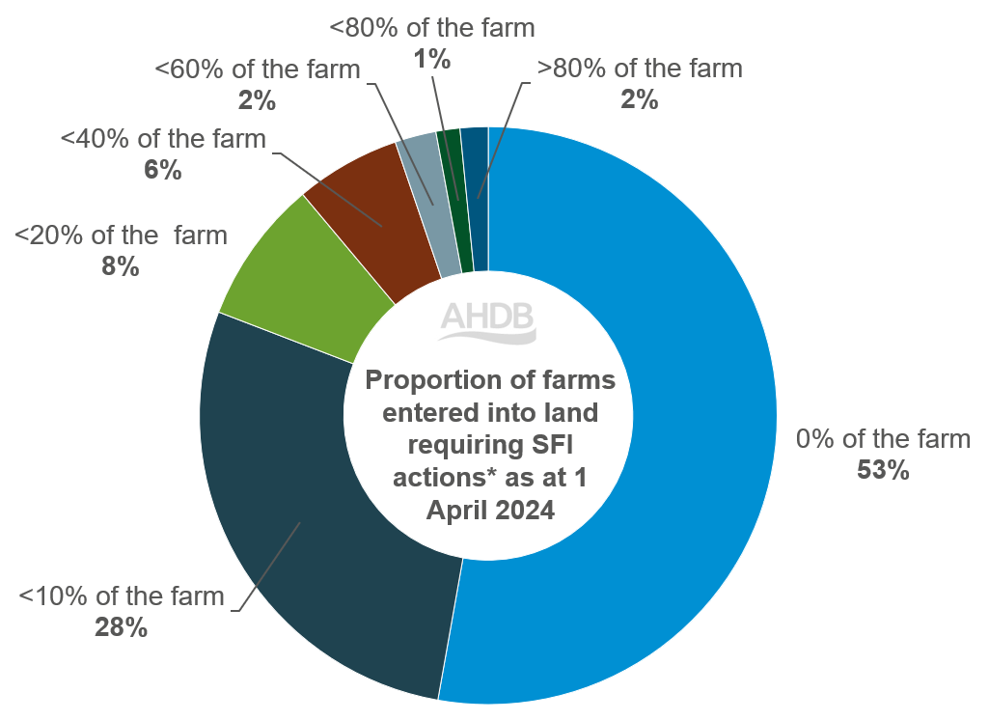Do SFI uptake stats ease concerns about land removed from food production?
Monday, 20 May 2024
Despite some unease regarding the amount of farming land entered into the Sustainable Farming Incentive (SFI), recent statistics suggest that this should not be a big concern.
Earlier this year, we highlighted in a blog post how there were questions being raised over the amount of productive farmland being entered into the SFI and the implications for food production.
Statistics released by Defra on 3 May 2024, show that out of the 13,400 farms entered into SFI 2023 (as at 1 April 2024) 81% of farms had entered less than 10% of their farmland into actions which require land (Figure 1).
Figure 1. Proportion of farms entered into SFI actions requiring land to be taken out of production as at 1 April 2024.

Source: Defra
*SFI actions include:
- AHL1 - Pollen and nectar flower mix
- AHL2 - Winter bird food on arable and horticultural land
- AHL3 - Grassy field corners or blocks
- AHL4 - 4m to 12m grass buffer strip on arable and horticultural land
- IGL1 - Take grassland field corners or blocks out of management
- IGL2 - Winter bird food on improved grassland
- IGL3 - 4m to 12m grass buffer strip on improved grassland
- IPM2 - Flower-rich grass margins, blocks, or in-field strips
Only 2% of farms had entered 80% or more of their farm. This correlates with conclusions from the SFI stacking analysis we carried out using AHDB virtual farms – it only makes financial sense to carry out these land requiring actions on unproductive or marginal areas of the farm.
For example, the AHDB 455 ha virtual arable farm had 8% of its farmland entered into such actions, while the virtual beef and sheep farms had 11-14% of their grassland entered into such actions.
On 25 March 2024, Defra announced that certain land requiring SFI actions could total no more than 25% of a farm’s total farmland. Looking ahead, it is, therefore, increasingly unlikely that considerable proportions of farmland will be entered into these actions.
SFI is intended to act as a buffer for farmers during challenging years but will do so to a lesser extent than the basic payment scheme.
How does SFI uptake compare with Countryside Stewardship (CS)?
As of the 1 April 2024, there was 34,900 CS agreements in place and 13,900 SFI 2023 agreements. However, it should be noted that the CS scheme is far more established, so this is to be expected.
Additionally, farm businesses can enter land into both the SFI and CS as long as equivalent actions are not carried out on the same area of land.
Figure 2. Area entered into selected SFI and equivalent CS actions as at 1 April 2024.
-2.png)
Source: Defra
- NUM3 – Legume fallow
- SAM2 – Multi-species winter cover crops
- SAM3 – Herbal leys
Please see Figure 1 for descriptions of other action codes.
Actions which proved the most popular tended to be those which can be easily implemented into current farming systems, as well as those which could provide benefits for cropping rotations.
Legume fallow (NUM3), winter cover crops (SAM2) and herbal leys (SAM3) proved the most popular SFI options requiring land. These actions were more popular than their equivalent CS options, for example the area entered into SFI herbal ley (SAM3) totalled 175 Kha, compared to the CS equivalent (GS4) of 84.7 Kha.
The area entered for SFI winter cover crops (SAM2) was 124 Kha, whereas 70.7 Kha was entered into the CS equivalent action (SW6).
Although equivalent actions in SFI and CS have the same aim and payment rates, they may differ in the manner they can be carried out as well as any restrictions which may apply.

